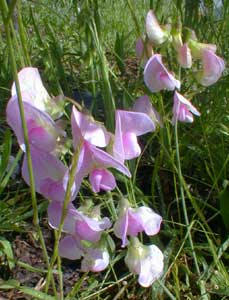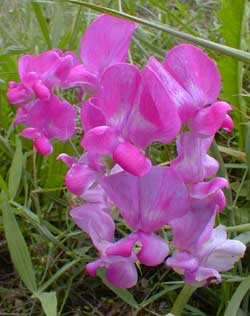
Invasive Perennial Sweet Pea
"Always before about my dooryard,
Marking the reach of the winter sea,
Rooted in sand & dragging driftwood,
Straggled the purple wild sweet pea."
-Edna St. Vincent Millay,
1892‚1950
1892‚1950
These snapshots of Lathyrus latifolius (synonymous with LL. megalanthus, membranaceus & sylvestris ssp. latifolius) are from the roadside in front of our house, & directly across the road in a meadowy field. The first photo is from late May, the second from September (2004), though forh ere in Zone 8 autumn rebloom is rare in comparison to late spring & summer flowerings.
Just about everywhere you go throughout the county, all summer long you see this stuff blooming along the roads. It is variously called Perennial Sweet Pea, Broadleaved Everlasting Pea, Brede Lathrys, & Wild Sweetpea or Pea-vine.
A native of southern Europe & northern Africa in cultivation since the early 1700s, the sweet pea has naturalized from one side of the North American continent to the other, having escaped from gardens just about everywhere it was ever grown. It grows wild in the majority of American states, though it has not naturalized in Florida because the subtropical humidity is too much for it, & it is not in North Dakota or Alaska because temperatures are too extreme.
 Thomas Jefferson planted his in 1807. During the Victorian era this thick vine had a popularity that qualified as a fad, with hundreds of named varieties that today no longer exist. They were typically named for famous individuals of the day, from best-selling novelists like Marie Corelli to members of the British Royal Family.
Thomas Jefferson planted his in 1807. During the Victorian era this thick vine had a popularity that qualified as a fad, with hundreds of named varieties that today no longer exist. They were typically named for famous individuals of the day, from best-selling novelists like Marie Corelli to members of the British Royal Family.Sweet pea commonly produces sports & is easily manipulated for color varieties. But the fad for so many varieties in time wore thin on the gardening public, After the first world war, catalogs that once offered scores of varieties began offering fewer & fewer.
It seems the escapees reverted to the natural pink, but now & then one spots odd-colored patches such as deep purple or pure white.
As with clover, perennial sweet pea helps fix nitrogen in the soil, improving very poor soil if planted temporarily. Plants do not like to be dug up & transplanted, but they grow well & swiftly from seeds. They are found most often in dry brightly sunlit locations but have also invaded woodland watersheds. It can mound upward to six or seven feet, with seemingly limitless spread.
It's too bad its young late summer seedpods or ripe autumn peas aren't especially edible since they're as plentiful as that other omnipresent invader with a seemingly limitless spread, old English blackberries. They are occasionally eaten, but since sweetpeas are mildly toxic & in sufficient quantities can cause disease of the nervous system, eating them is not advisable.
It occasionally seeds into our main gardens but we remove young plants to the compost. It is not difficult to keep at bay, unlike the morning glories that cannot be overcome.
I actually enjoy seeing the sweet pea & enjoy having a wild meadow-area immediately across the street, though one does lament the displacement of native wildflowers.